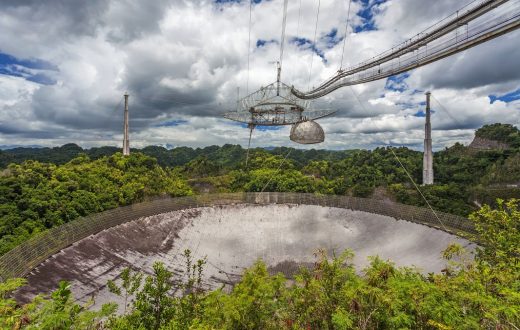
He had used the telescope just last week to observe a favorite target, Barnard’s star, one of the stars closest to Earth. When Méndez saw the photo of the latest damage, he was in disbelief. Read: An interstellar tourist barrels through the solar system “You can still use the observatory, but it won’t be as sensitive as before." Now they will have to begin the effort anew. “That takes a lot of time,” Abel Méndez, an astrobiologist who directs Arecibo’s Planetary Habitability Laboratory, told me. Even three years after the storm, although the structural damage had been repaired, technicians were still in the careful process of recalibrating the dish to restore its sensitivity to high-frequency radio waves. When the cable fell this week, Arecibo was still recovering from Hurricane Maria. Researchers managed to study the asteroid for two and a half hours, just enough time to learn about its shape and orbit. Arecibo went quiet as the storm approached, then leapt into action as soon as it passed. An asteroid that astronomers wanted to observe zoomed past Earth just as Tropical Storm Isaias struck Puerto Rico in July. Even in the middle of a plague, Arecibo found itself facing more natural disasters. The coronavirus pandemic has prevented astronomers from visiting Arecibo, but the telescope can be operated remotely, so the work continued. The dish wasn’t damaged, not like it was after an earthquake in 2014, but the observatory was forced to stop operations until the shaking from nearly a dozen quakes subsided. The tremors, some as strong as 6.4 magnitude, made observations impossible, and no one was allowed on-site. Then, in January of this year, the earthquakes came. Read: What happens if China makes first contact? Some feared the hurricane damage would make the NSF pull the plug, but the foundation eventually negotiated an agreement with a trio of institutions to take over operations, and astronomers around the world sighed in relief. The National Science Foundation, which owns Arecibo, was already considering passing the observatory off to someone else so it could focus-and spend money on-other, new projects. The hurricane struck at a moment when Arecibo’s future seemed more uncertain than ever. But the observatory was back up and running within a week, powered by generators. During the storm, an antenna suspended over the observatory fell and punctured the dish, tearing a hole in the aluminum. The observatory famous for once broadcasting a radio message into the cosmos intended for any intelligent civilizations fell silent. In September 2017, Hurricane Maria devastated Puerto Rico, knocking out power across the island for months. The trials that Arecibo has experienced over the years sound almost biblical in their proportions. Earth is the only home we’ve got in the universe, but sometimes the planet can really ruin the view. In its efforts to survey the cosmos and uncover worlds beyond imagination, the observatory has been repeatedly derailed by the most earthly of obstacles. It might be tempting to react to this photograph in the way many of us have responded recently to bits of bad news against the backdrop of the pandemic: Really, 2020? You couldn’t leave Arecibo alone? But Arecibo has experienced its share of disasters, large and small. For now, the telescope has paused observations. Engineers don’t know yet what caused the cable to break. “We have seen nothing like this at Arecibo before,” Zenaida Gonzalez Kotala, a spokesperson for the University of Central Florida, one of the institutions that operates the observatory, told me. The mesh of steel cables supporting the massive dish broke too, dropping debris on the grass below. The force of the impact ripped a 100-foot-long gash in the aluminum. A metal support cable snapped and fell into the dish. The telescope’s latest mishap unfolded earlier this week, in the middle of the night. Arecibo is where the field of SETI, the search for extraterrestrial intelligence, began in earnest, with visionaries who believed that someday we would make that triumphant first contact. It is one of the most powerful telescopes in the world. Over the years, Arecibo has produced a trove of scientific discoveries inside the solar system and beyond. The real Arecibo Observatory, built inside a natural sinkhole in Puerto Rico, is just as breathtaking as it looks in the movies, and it has provided countless observations to many real astronomers since it began operating in 1963. In one scene, she gazes at the cavernous 1,000-foot radio dish, nestled in lush mountains, under a clear, blue sky. Ellie Arroway works at the Arecibo Observatory, scanning the skies for mysterious radio signals from faraway stars.

ARECIBO TELESCOPE DAMAGE BY MARIA MOVIE
If the name Arecibo sounds familiar, it is probably because you’ve seen Contact, the 1997 movie adaptation of Carl Sagan’s sci-fi novel of the same name.

Arecibo Observatory / University of Central Florida


 0 kommentar(er)
0 kommentar(er)
